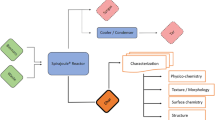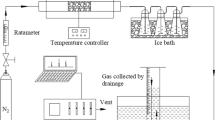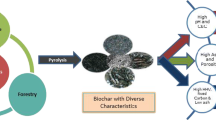Abstract
The use of biomass has been a recent trend as a potential feedstock for char generation with improved energetic value. In this work, agricultural residues such as sugarcane bagasse (SCB) and rice husk (RH) were submitted to slow pyrolysis and their calorific value potential was evaluated in comparison with industrial woodchip biochar (WC) (Pyreg GmbH). The samples were characterized by thermogravimetry (TG), differential thermal analysis (DTA), elemental analysis (CNHS) and Fourier-transform infrared spectroscopy. The chars/biochar had a high energetic profile, as indicated by the prominent exothermic peaks in DTA curves, along with the major mass losses, as demonstrated in the TG curves. The combination of fixed carbon (FC) and ash content (A) proved to be essential to produce a char with enhanced higher heating value (HHV), as observed for SCB (FC = 54.6%; A = 6.2%) and RH (FC = 51.0%; A = 38.4%). SCB and RH chars presented an improved stability reflected by a C/N molar ratio higher than 90%. The low nitrogen content (SCB = 0.8%; RH = 0.6%) and surface area (SCB = 6.0 m2 g−1; RH = 11.2 m2 g−1) of the produced chars suggest that they are not indicated for agricultural applications, unless chemical activation is applied. Furthermore, the post-treatment applied for WC (biological activation) is possibly the cause for the improved physicochemical properties, particularly in terms of potential soil conditioning, at the expense of estimated calorific value.



Similar content being viewed by others
References
Colantoni A, Evic N, Lord R, Retschitzegger S, Proto AR, Gallucci F, Monarca D. Characterization of biochars produced from pyrolysis of pelletized agricultural residues. Renew Sust Energy Rev. 2016;4:187–94. https://doi.org/10.1016/j.rser.2016.06.003.
He X, Liu Z, Niu W, Yang L, Zhou T, Qin D, Niu Z, Yuan Q. Effects of pyrolysis temperature on the physicochemical properties of gas and biochar obtained from pyrolysis of crop residues. Energy. 2018;143:746–56. https://doi.org/10.1016/j.energy.2017.11.062.
Dunnigan L, Ashman PJ, Zhang X, Kwong CW. Production of biochar from rice husk: particulate emissions from the combustion of raw pyrolysis volatiles. J Clean Prod. 2018;172:1639–45. https://doi.org/10.1016/j.jclepro.2016.11.107.
Food and Agriculture Organization of the United Nations (FAO). Rice market monitor. 2017; 3.
Mohd Esa N, Ling TB. By-products of rice processing: an overview of health benefits and applications. Rice Re Open Access. 2016;4(1):1–11. https://doi.org/10.4172/jrr.1000107.
Zhang H, Ding X, Chen X, Ma Y, Wang Z, Zhao X. A new method of utilizing rice husk: consecutively preparing d-xylose, organosolv lignin, ethanol and amorphous superfine silica. J Hazard Mater. 2015;291:65–73. https://doi.org/10.1016/j.jhazmat.2015.03.003.
Dunnigan L, Morton BJ, Ashman PJ, Zhang X, Wai C. Emission characteristics of a pyrolysis-combustion system for the co-production of biochar and bioenergy from agricultural wastes. Waste Manag. 2018;77:59–66. https://doi.org/10.1016/j.wasman.2018.05.004.
Companhia Nacional de Abastecimento (CONAB). Acompanhamento da safra brasileira: cana-de-açúcar; 2018/2019, August 2018. vol. 5, 76p.
David GF, Justo OR, Perez VH, Garcia-Perez M. Thermochemical conversion of sugarcane bagasse by fast pyrolysis: high yield of levoglucosan production. J Anal Appl Pyrolysis. 2018;33:246–53. https://doi.org/10.1016/j.jaap.2018.03.004.
Haykiri-Acma H, Yaman S, Kucukbayrak S. Comparison of the thermal reactivities of isolated lignin and holocellulose during pyrolysis. Fuel Sci Technol. 2010;91(7):759–64. https://doi.org/10.1016/j.fuproc.2010.02.009.
Günther B, Gebauer K, Barkowski R, Rosenthal M, Bues CT. Calorific value of selected wood species and wood products. Eur J Wood Wood Prod. 2012;70(5):755–7. https://doi.org/10.1007/s00107-012-0613-z.
Todaro L, Rita A, Cetera P, D’Auria M. Thermal treatment modifies the calorific value and ash content in some wood species. Fuel. 2015;140:1–3. https://doi.org/10.1016/j.fuel.2014.09.060.
Prost K, Borchard N, Siemens J, Kautz T, Séquaris JM, Möller A, Amelung W. Biochar affected by composting with farmyard manure. J Environ Qual. 2013;42:164–72.
Schulz H, Dunst G, Glaser B. Positive effects of composted biochar on plant growth and soil fertility. Agron Sustain Dev. 2013;33:817–27.
Rajapaksha AU, Vithanage M, Ahmad M, Seo DC, Cho JS, Lee SE, Lee SS, Ok YS. Enhanced sulfamethazine removal by steam-activated invasive plant-derived biochar. J Hazard Mater. 2015;290:43–50. https://doi.org/10.1016/j.jhazmat.2015.02.046.
Pyreg. Biomass characteristics of a Pyreg System. http://www.pyreg.de/wp-content/uploads/04_biomass_characteristics_PYREG_system.pdf. Accessed 3 Oct 2018.
Parikh J, Channiwala SA, Ghosal GK. A correlation for calculating elemental composition from proximate analysis of biomass materials. Fuel. 2007;86(12–13):1710–9. https://doi.org/10.1016/j.fuel.2006.12.029.
García R, Pizarro C, Lavín AG, Bueno JL. Biomass proximate analysis using thermogravimetry. Bioresour Technol. 2013;139:1–4. https://doi.org/10.1016/j.biortech.2013.03.197.
Malucelli LC, Silvestre GF, Carneiro J, Vasconcelos EC, Guiotoku M, Maia CMBF, Carvalho Filho MAS. Biochar higher heating value estimative using thermogravimetric analysis. J Therm Anal Calorim 2019;1–6.
Parikh J, Channiwala SA, Ghosal GK. A correlation for calculating HHV from proximate analysis of solid fuels. Fuel. 2005;84(5):487–94. https://doi.org/10.1016/j.fuel.2004.10.010.
Sun Y, Gao B, Yao Y, Fang J, Zhang M, Zhou Y, Chen H, Yang L. Effects of feedstock type, production method, and pyrolysis temperature on biochar and hydrochar properties. Chem Eng J. 2014;240:574–8. https://doi.org/10.1016/j.cej.2013.10.081.
Johar N, Ahmad I, Dufresne A. Extraction, preparation and characterization of cellulose fibres and nanocrystals from rice husk. Ind Crops Prod. 2012;37(1):93–9. https://doi.org/10.1016/j.indcrop.2011.12.016.
Cruz G, Crnkovic PM. Investigation into the kinetic behavior of biomass combustion under N2/O2 atmosphere. J Therm AnalCalorim. 2016;123:1003–11.
Almeida S, Crespi MS, Nozela WC, Dias DS, Silva FR, Torquato LDM, Ribeiro CA, Marchi MRR. Food waste: energy source. J Therm Anal Calorim. 2018;134:1367.
Yuan W, Boyette MD, Wang D, Kumar A. Characterization of biochar from rice hulls and wood chips produced in a top-lit updraft biomass gasifier. Trans ASABE. 2016;59(3):749–56.
Kizito S, Luo H, Lu J, Bah H, Dong R, Wu S. Role of nutrient-enriched biochar as a soil amendment during maize growth: exploring practical alternatives to recycle agricultural residuals and to reduce chemical fertilizer demand. Sustainability. 2019;11(11):3211.
Zhao B, O’Connor D, Zhang J, Peng T, Shen Z, Tsang DCW, Hou D. Effect of pyrolysis temperature, heating rate, and residence time on rapeseed stem derived biochar. J Clean Prod. 2018;174:977–87. https://doi.org/10.1016/j.jclepro.2017.11.013.
Yu J, Sun L, Berrueco C, Fidalgo B, Paterson N, Millan M. Influence of temperature and particle size on structural characteristics of chars from Beechwood pyrolysis. J Anal Appl Pyrolysis. 2018;130:127–34. https://doi.org/10.1016/j.jaap.2018.01.018.
Lee Y, Park J, Ryu C, Gang KS, Yang W, Park YK, Jung J, Hyun S. Comparison of biochar properties from biomass residues produced by slow pyrolysis at 500°C. Bioresour Technol. 2013;148:196–201. https://doi.org/10.1016/j.biortech.2013.08.135.
Spokas KA. Review of the stability of biochar in soils: predictability of O: C molar ratios. Carbon Manag. 2010;1(2):289–303. https://doi.org/10.4155/cmt.10.32.
Grutzmacher P, Puga AP, Bibar MPS, Coscione AR, Packer AP, de Andrade CA. Carbon stability and mitigation of fertilizer induced N2O emissions in soil amended with biochar. Sci Total Environ. 2018;625:1456–66. https://doi.org/10.1016/j.scitotenv.2017.12.196.
Bakshi S, Banik C, Laird DA. Quantification and characterization of chemically-and thermally-labile and recalcitrant biochar fractions. Chemosphere. 2018;194:247–55. https://doi.org/10.1016/j.chemosphere.2017.11.151.
Oldfield TL, Sikirica N, Mondini C, López G, Kuikman PJ, Holden NM. Biochar, compost and biochar-compost blend as options to recover nutrients and sequester carbon. J Environ Manag. 2018;218:465–76.
Yang X, Kwon EE, Dou X, Zhang M, Kim KH, Tsang DCW, Ok YS. Fabrication of spherical biochar by a two-step thermal process from waste potato peel. Sci Total Environ. 2018;626:478–85. https://doi.org/10.1016/j.scitotenv.2018.01.052.
Narzari R, Bordoloi N, Sarma B, Gogoi L, Gogoi N, Borkotoki B, Kataki R. Fabrication of biochars obtained from valorization of biowaste and evaluation of its physicochemical properties. Bioresour Technol. 2017;242:324–8. https://doi.org/10.1016/j.biortech.2017.04.050.
Basso AS, Miguez FE, Laird DA, Horton R, Westgate M. Assessing potential of biochar for increasing water-holding capacity of sandy soils. Gcb Bioenergy. 2013;5:132–43.
Chen B, Johnson EJ, Chefetz B, Zhu L, **ng B. Sorption of polar and nonpolar aromatic organic contaminants by plant cuticular materials: role of polarity and accessibility. Environ Sci Technol. 2005;39(16):6138–46. https://doi.org/10.1021/es050622q.
Tag AT, Duman G, Ucar S, Yanik J. Effects of feedstock type and pyrolysis temperature on potential applications of biochar. J Anal Appl Pyrolysis. 2016;120:200–6. https://doi.org/10.1016/j.jaap.2016.05.006.
Peng H, Gao P, Chu G, Pan B, Peng J, **ng B. Enhanced adsorption of Cu(II) and Cd(II) by phosphoric acid-modified biochars. Environ Pollut. 2017;229:846–53. https://doi.org/10.1016/j.envpol.2017.07.004.
Song W, Guo M. Quality variations of poultry litter biochar generated at different pyrolysis temperatures. J Anal Appl Pyrolysis. 2012;94:138–45. https://doi.org/10.1016/j.jaap.2011.11.018.
Acknowledgements
The authors thank Conselho Nacional de Desenvolvimento Científico e Tecnológico (National Council of Technological and Scientific Development) and Embrapa Florestas for financial support.
Author information
Authors and Affiliations
Corresponding author
Additional information
Publisher's Note
Springer Nature remains neutral with regard to jurisdictional claims in published maps and institutional affiliations.
Rights and permissions
About this article
Cite this article
Malucelli, L.C., Carneiro, J., Vasconcelos, E.C. et al. Energetic potential of pyrolyzed biomass from different sources: a comparative study. J Therm Anal Calorim 141, 1149–1155 (2020). https://doi.org/10.1007/s10973-019-09061-3
Received:
Accepted:
Published:
Issue Date:
DOI: https://doi.org/10.1007/s10973-019-09061-3




